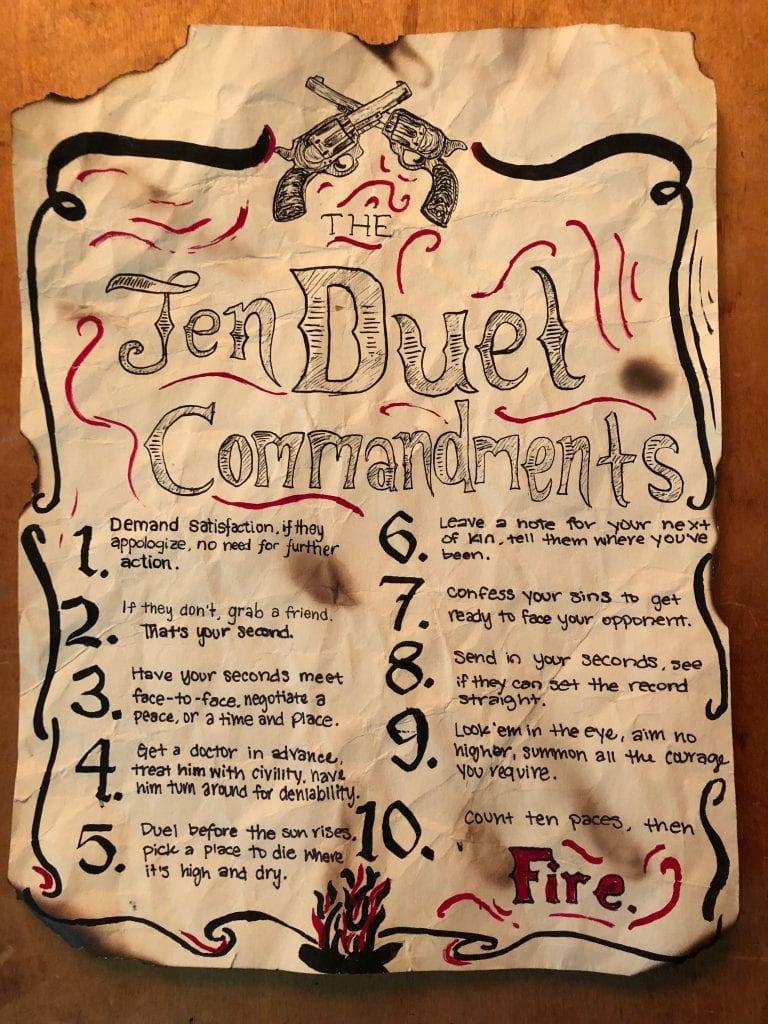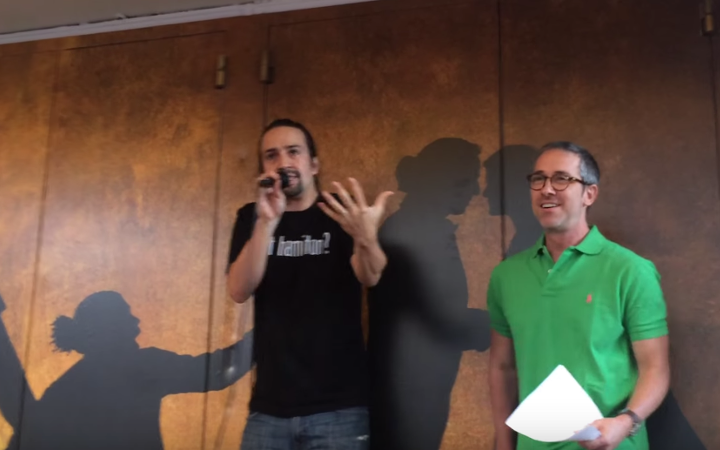by: Emily Moseley
My idea for this remix and adaptation project started as a sort of play off Ham4Pamphlet. I am a visual thinker and every time I listened to Hamilton’s songs I had to stop what I was doing to really picture what was happening in the song and most times I was able to create a mood, font, and graphic in my head. So my original idea was to do something similar, but for a few of the people of Hamilton. This was a great idea; however, I quickly realized that I’m a typography and structured artist, not much of a people-drawing artist. So in my revisions and feedback, I was able to reshape this idea into what it is currently. I stuck to having two of my graphics being people-based (off Thomas Jefferson and Alexander Hamilton) and the third was meant to be something more my style, a graphic of the Ten Duel Commandments.
The student who reviewed my proposal gave great, critical feedback that helped shaped my project. I came to him with the Hamilton/Jefferson/Ten Duel Commandments plan (pictured below), and he hinted at small tweaks I could make as well as small additions that would help tie this to Hamilton and make it even more historically accurate.
On the left you can see Alexander Hamilton, fairly similar to how he looks in his final form. I used oil pastels to create his rough, aged face and was unsure what I wanted to put in his eyeglasses so I drew some sketches around the page. Ultimately, I relied on the description I had come up with for each eyeglass for the final painting; however, starting the conversation early helped a lot.

In the middle, I have a much rougher draft of my Thomas Jefferson piece. This started when I found a sassy drawing of Jefferson portrayed as Daveed Diggs (right) and it gave me an idea for this graphic using one of his lines from Cabinet Battle #1. His personality in the show was so strong and I felt that it was a perfect candidate to show how two-sided politicians can be, especially back then with issues such as slavery on the table. It wasn’t until my feedback from the peer-review that I added the farmscape with his slaves in, giving his snapping fingers more of a purpose and an opportunity to show his home life.
Lastly, you can see an early version of the Ten Duel Commandments graphic. This idea did not change much under peer-review, though I did try to emphasize the “secret” nature of dueling in it’s final state because dueling was illegal in New York at the time. This was an unofficial, unlawful document that signifies the rules that we learned in the show Hamilton. Each bullet point is a line taken directly out of the show, or tweaked slightly for context purposes. Essentially, this piece was made to represent that song, and be a document that looks like it could have been created at the time that this show’s events happened.
Below you can see each of my pieces in their final state, after all the revisions, additions, and tweaks.

All in all, this piece on Alexander Hamilton is supposed to capture the trials and tribulations he went through to shape this country. From his early childhood, he suffered many loses including his mother (who’s lying in bed in his left eyeglass) and his home (because of the hurricane that destroyed everything he knew). Despite everything, he made a name for himself, worked hard, and became a Founding Father. His greatest contribution was the Federal Banking System and he is pictured presenting it to other congressmen in the right eyeglass. Zooming back out, Alexander Hamilton himself is wearing his famous reading glasses that hold these two images and he is clearly aged, worn, tired, and bleeding. The bloody nose represents the blood he shed to get to and shape this country. This is to honor his time spend fighting in the Revolutionary War and his early death in the duel between him and Aaron Burr in 1804.

The goal of this piece is to show Jefferson’s strong personality, two-faced politics, and influence on this country. The quote on the right is from the show Hamilton, Cabinet Battle #1, and his crazy hair is also a reference to the show and Daveed Diggs. By putting the French flag in the background, I’m showing his history with France and his time spent overseas. His stance and snapping fingers are a tribute to his cocky character and the slaves and farmland on the left are showing how partial he is to Virginia and his old way of life. This shows what most people don’t know about Thomas Jefferson: he was far from perfect and very selfish.

Even though dueling was illegal in New York at the time, the show Hamilton had such a structured way of talking about dueling that I felt it required a somewhat official documentation of the illegal act. The song The Ten Duel Commandments in the show was a large turning point, and is what ultimately killed Hamilton. The reverberations of Hamilton’s death were felt by just about everyone at the time, which is represented by the fire that consumes the page. The page is meant to be an old document from the 1800s which is why it is so worn, from being hidden from the law and passed around between many people. Finally, the two handguns at the top of the page represent the weapons one would bring to a duel, as well as the ones that Hamilton and Burr used in their duel.














